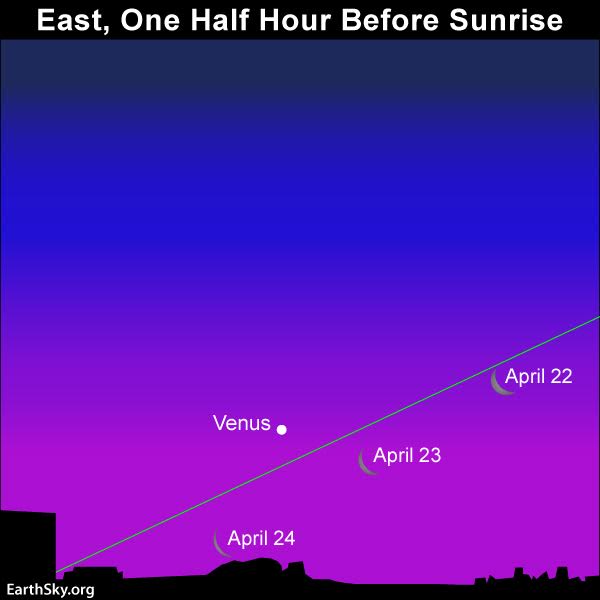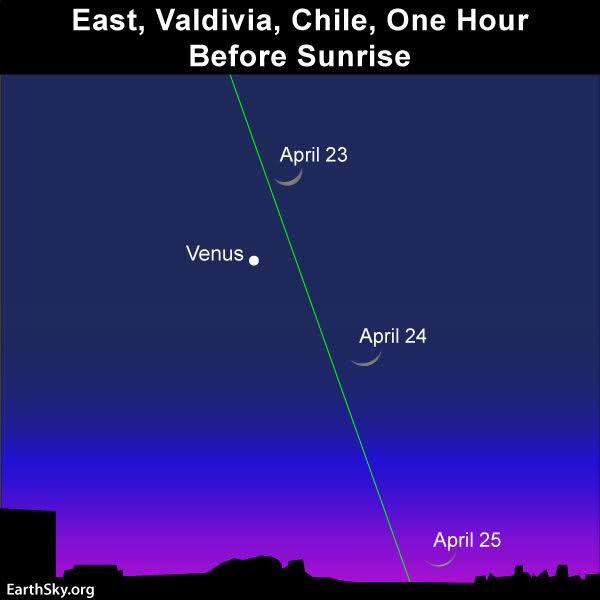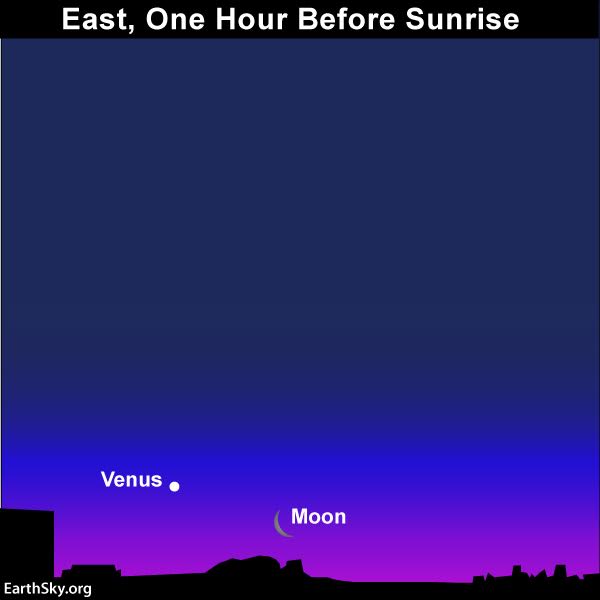Tomorrow morning – April 23, 2017 – watch the beautiful pairing of the waning crescent moon with the dazzling planet Venus in your eastern sky before sunrise. Because the moon and Venus rank as the second-brightest and third-brightest celestial bodies, respectively, after the sun, you might be able to spot Venus close to the moon shortly before sunrise – or possibly, even after the sun comes up. But we recommend getting up at least an hour before sunup to more fully enjoy the glorious morning spectacle.
From mid-northern latitudes, the moon and Venus come up shortly after the first glimmers of dawn. For instance, at Philadelphia, Pennsylvania (40o north latitude), the moon and Venus rise about one and one-half hours before sunrise on April 23. Farther north, the moon and Venus rise closer to the time sunrise and sit lower in the glare of morning twilight. So, if you want to catch the moon and Venus from far-northerly latitudes, you’ll want to find an unobstructed eastern horizon!
If you live in the U.S. or Canada, click here to find out the rising times for the sun, moon and Venus in your sky. If you live elsewhere worldwide, click here.

The farther south you live, the sooner the moon and Venus rise before sunrise and the higher these two worlds climb into your predawn/dawn sky. For instance, some 80o of latitude to the south of Philadelphia, at Valdivia, Chile in South America (40o south latitude), the moon rises nearly three hours before the sun and Venus rises about three and one-half hours before the sun.
Venus transitioned from the evening to the morning sky about a month ago, around the time of the March 20 equinox. For the Northern Hemisphere, the March equinox is the spring equinox; and for the Southern Hemisphere, the March equinox is their autumn equinox. In either the Northern or Southern Hemisphere, the ecliptic – the pathway of the sun, moon and planets – intersects the horizon at an extremely shallow angle on springtime mornings, yet at an extremely steep angle on autumn mornings.
At present, the steep tilt of the ecliptic relative to the morning horizon causes the moon and Venus to rise earlier before sunrise in the Southern Hemisphere than at comparable latitudes in the Northern Hemisphere. Contrast the tilt of the ecliptic on the sky chart above (40oo south latitude).

By the way, the planets Venus and Mars have a conjunction in the morning sky on October 5, 2017. Because October is an autumn month in the Northern Hemisphere yet a springtime month for the Southern Hemisphere, the tilt of the ecliptic will then favor the Northern Hemisphere. On October 5 at Philadelphia, PA (40o north latitude), Mars and Venus will rise about two hours before the sun – yet on October 5 at Valdivia, Chile, the two worlds will rise only about 50 minutes before sunrise.
The tilt of the ecliptic in the April 2017 morning sky makes all the difference in the rising times of the moon and Venus from Philadelphia, PA and Valdivia, Chile. And the tilt of the ecliptic in the October 2017 morning sky will again make all the difference for the rising times of Venus and Mars at northerly and southerly latitudes.
Bottom line: Whether you’re north or south of the equator, enjoy the the waning moon and Venus as they light up the sky on the morning of April 23, 2017.












